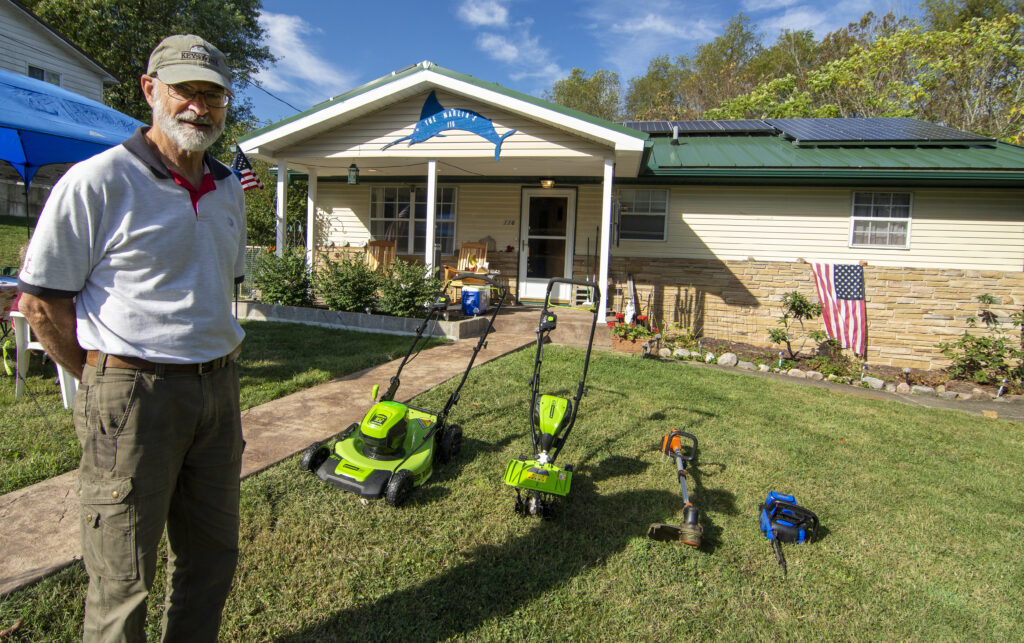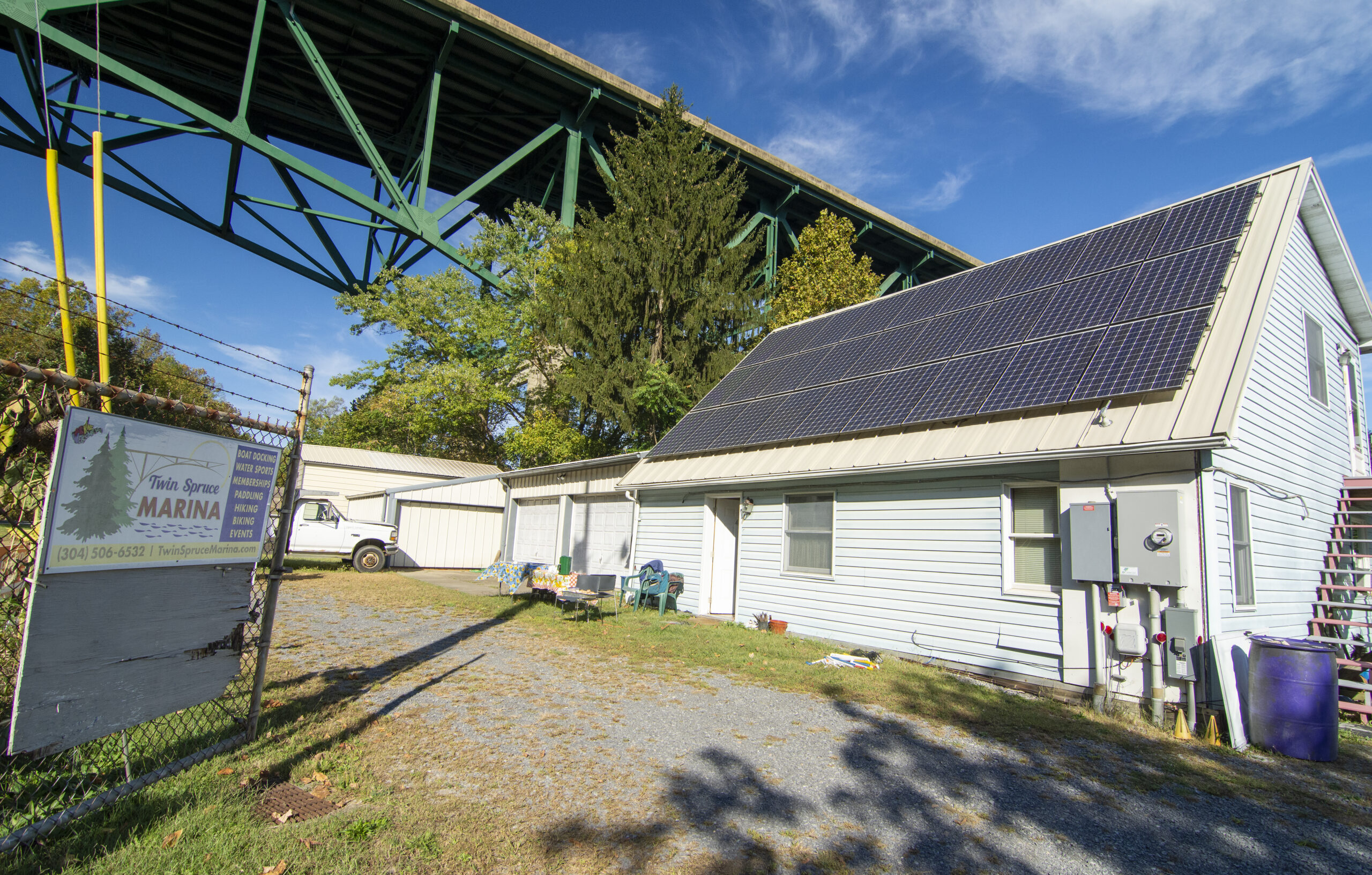Andy Cockburn’s electric bill last month was $5.
That covered all the appliances, all the electronics and everything else plugged in at the 2,600-square-foot ranch house the retired WVU professor shares with his wife in the Stewartstown Road area.
In the case of the Cockburn abode, “everything” really does mean everything.
The couple’s Chevy Bolt electric car was charging in the garage on the rainy Sunday afternoon.
“I’m basically using Mon Power for a battery,” he said.
Make that, a backup battery.
That’s because the sun is doing all the heavy lifting.
This weekend marked the 24th annual Solar Tour, a national event showcases homes and business that rely solely (or, almost solely) on Old Sol to generate the amperage.
His solar-paneled house, plus a handful of other similarly outfitted homes and businesses in Morgantown and Westover, were tapped for the tour’s north-central West Virginia leg.
The tour is sponsored nationally by Solar United Neighbors and the American Solar Energy Society.
Both advocate for power sources besides coal and other fossil fuels.
Solar United Neighbors, based in Washington, D.C., helps private citizens like Cockburn go solar, while also lobbying for energy rights and energy alternatives.
From its headquarters in Boulder, Colo., the American Solar Energy Society’s membership is made up of renewable energy professionals and advocates in 41 states and the District of Columbia.
Flipping the switch — on what used to be
No matter your stances on climate change or oil consumption, said Carly Rixham, the association’s executive director, retrofitting for the reliance of solar can’t help but be a ray of sunshine for beleaguered ecosystems and household budgets.
“It allows people to reduce costs, support energy independence, protect against power outages and reduce carbon emissions,” she said.
The weekend comes as West Virginia, which hung its fortunes on coal for generations, is acknowledging new realities while also considering new possibilities.
In the Morgantown area, the Longview Power Plant on Fort Martin Road is looking to add a 350-acre solar component to its current expansion plans.
That means a new power source with the potential to generate as much as
70 megawatts when the sun is shining, plant officials said last month.
Evan Hansen said he would like to see the Mountain State do some new energy mining of its own.
Hansen is a longtime alternative energy booster who represents Monongalia County in the state House of Delegates.
His Downstream Strategies environmental consulting company was on this weekend’s solar tour.
Such an effort, he said, could be undertaken with the help of some familiar, and now discarded,
infrastructure.
He wants to shine the light on new solar opportunities in a state still hitched to a now-flagging coal industry.
The leftover infrastructure of the once-booming coal years here even factors in, he said.
Hansen talked about it with The Dominion Post in January, right before the start of the 2019 Legislative session.
What he wants to do is offer up bills that will allow the development of solar farms — without what he says are undue regulations from the state Public Service Commission — so long as those entities are situated at sites of abandoned coal operations.
“There are old abandoned coal mines from decades ago,” he said.
“And mountaintop-mining sites from 10 and 20 years ago in southern West Virginia.”

(Jason DeProspero/For The Dominion Post)
Lighting up the pocketbook
The idea, he said, is to repurpose blighted lands that are currently neither “healthy” nor safe, while also offering incentives for solar-minded businesses to set up here or relocate here.
He would also like to help put Solar United Neighbors of West Virginia in the spotlight.
That’s the nonprofit advocating for solar use among state residents, with the goal of making Power Purchase Agreements — or PPAs — legal in the state.
PPAs, said Autumn Long, the program director for Solar United Neighbors, are why homeowners want to harness the sun in the first place.
Here’s how PPAs work: A tax-paying, third-party developer installs, owns and operates a distributed energy system on a customer’s property.
The customer then “buys” said system’s electric output at a lower, fixed rate for a predetermined time period that usually runs 15 to 25 years.
Homeowners, as she said, benefit from the agreement. But so do municipalities, schools, churches, hospitals and nonprofits.
PPAs are currently legal in 26 states, including West Virginia’s neighbors of Pennsylvania, Ohio and Maryland.
This past January, West Virginia, Hansen reported, was then producing about 7 megawatts of solar-produced energy, as opposed to 373 megawatts in Pennsylvania and 631 megawatts in Virginia.
And the Pennsylvania and Virginia numbers, while vastly outpacing the Mountain State, are relatively low compared to other states.
“But that’s already changing,” he said then. “And we’re going to continue to be left behind.”
Dual-power mission
Cockburn two months ago had a total of 32 solar panels installed on the roof of his house and its garage. Both sets catch the full rays of the sun, both in the morning and late afternoon.
“I didn’t plan that,” he said, “but it really works out.”
A Huntington company did the work, and after the tax credit he received for making his house more energy efficient, the price tag was around $16,000.
Those $5 utility bills will help him recoup the initial investment in no time, he said.
“I like that we’re doing the right thing,” said the professor, who also owns a Toyota Prius, along with his other electric car.
“But I like that we’re saving money, too. So whatever your motivation, it’s a good idea.”




